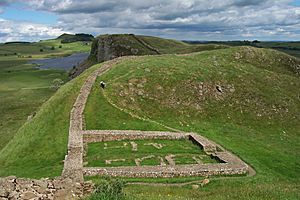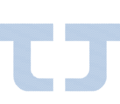Milecastle facts for kids
A milecastle was a small fort built by the Roman Empire. These forts were shaped like rectangles. They were placed about one Roman mile apart along important borders. A famous example is Hadrian's Wall in Great Britain. This is why they are called "milecastles."
Along Hadrian's Wall, milecastles were first made from stone in the east. In the west, they were built from stacked turf and wood. Later, the turf milecastles were rebuilt with stone. Their size varied, but they were usually about 15 by 18 meters inside. Their stone walls were often 3 meters thick. These walls were likely 5 to 6 meters high, matching the main wall. There were 80 milecastles and 158 turrets on Hadrian's Wall.
Each milecastle on Hadrian's Wall usually had a gate. This gate went through the wall and had a path across the ditch. About 20 to 30 Roman soldiers lived in two barracks inside. On each side of a milecastle, there was a stone tower called a turret. These turrets were about one-third of a Roman mile away. The soldiers from the milecastle likely guarded these turrets too. Milecastles controlled who and what crossed the border. They probably also collected taxes on goods passing through.
A similar system of small forts, called milefortlets, stretched west from Hadrian's Wall. These went along the Cumbrian coast to Tower 25B at Flimby. They were connected by a wooden fence, not a stone wall. Unlike milecastles, they did not have gates through their fence.
Contents
Understanding Milecastles and Their Names
The name milecastle became official in 1708. However, local people used it even before then. This term usually means the forts connected to the main wall. The word 'Milefortlet' is used for similar forts along the Cumbrian coast. These were built at the same time as the milecastles. Small towers between milefortlets are simply called 'towers'.
Milecastles are numbered from 1 in the east to 80 in the west. This numbering system started in the late 1800s. It became standard around 1930. Some experts think there might have been a Milecastle 0. Milefortlets are numbered from 1 (west of Bowness on Solway) up to possibly 26. People often use short names like 'MC1' for Milecastle 1 or 'MF1' for Milefortlet 1. Turrets and towers between them get a letter, like 'T20a' or 'T20b'.
Sometimes, the original turf wall and the later stone wall went in different directions. In these cases, milecastles and turrets on the turf wall get a 'TW' added to their name. For example, 'MC50 TW'.
Milecastle Designs and Gateways
Milecastles on Hadrian's Wall had three main types of gateways. These types show how the Roman legions built them.
Gateway Types
- Type I gateways had stone supports sticking out on both sides of the gate. The walls of the passage were made of large stones. These milecastles were wider from east to west than they were deep from north to south. Legio II Augusta is thought to have built these. Examples include MC 38 (Hotbank) and MC 42 (Cawfields).
- Type II gateways had supports sticking out only on the inside of the gate. The stone used was smaller than in Type I. These are found on milecastles built with the Narrow Wall design. If similar gates are on Broad Wall milecastles, they are sometimes called Type IV. Legio XX Valeria Victrix likely built these. MC 9 (Chapel House) is an example.
- Type III gateways also had supports sticking out on the inside. But they also had supports on both the inside and outside. The main supports were large stones, but the passage walls used smaller stones. Legio VI Victrix is believed to have built these. Examples are MC 47 (near Gilsland) and MC 48 (Poltross Burn).
Milecastle Shapes
Milecastles also came in two main shapes: 'Long Axis' and 'Short Axis'. This refers to the length between the north and south gates. The only known exception is Milecastle 79. This was a turf wall milecastle that was later rebuilt in stone.
- Short-axis milecastles were built by Legio II Augusta and had Type I gateways.
- Long-axis milecastles were built by Legio XX Valeria Victrix (with Type II and IV gateways) and Legio VI Victrix (with Type III gateways).
What a Milecastle Might Have Looked Like
These pictures show what a milecastle might have looked like. They are based on Housesteads Milecastle (Milecastle 37).
You can find the 3D model file online at [1].
List of Milecastles
| Number | Name |
|---|---|
| 0 | (unnamed, existence uncertain) |
| 1 | Stott's Pow |
| 2 | Walker |
| 3 | Ouseburn |
| 4 | Westgate Road |
| 5 | Quarry House |
| 6 | Benwell Grove |
| 7 | Benwell Bank |
| 8 | West Denton |
| 9 | Chapel House |
| 10 | Walbottle Dene |
| 11 | Throckley Bank Top |
| 12 | Heddon |
| 13 | Rudchester Burn |
| 14 | March Burn |
| 15 | Whitchester |
| 16 | Harlow Hill |
| 17 | Welton |
| 18 | East Wallhouses |
| 19 | Matfen Piers |
| 20 | Halton Shields |
| 21 | Down Hill |
| 22 | Portgate |
| 23 | Stanley |
| 24 | Wall Fell |
| 25 | Codlawhill |
| 26 | Planetrees |
| 27 | Low Brunton |
| 28 | Walwick |
| 29 | Tower Tye |
| 30 | Limestone Corner |
| 31 | Carrowburgh |
| 32 | Carraw |
| 33 | Shield-on-the-Wall |
| 34 | Grindon |
| 35 | Sewingshields |
| 36 | King's Hill |
| 37 | Housesteads |
| 38 | Hotbank |
| 39 | Castle Nick |
| 40 | Winshields |
| 41 | Melkridge |
| 42 | Cawfields |
| 43 | (Unnamed?) |
| 44 | Allolee |
| 45 | Walltown |
| 46 | Carvoran |
| 47 | Chapel House |
| 48 | Poltross Burn |
| 49 | Harrow's Scar |
| 50 | Turf Wall |
| 51 | Wall Bowers |
| 52 | Bankshead |
| 53 | Banks Burn |
| 54 | Randylands |
| 55 | Low Wall |
| 56 | Walton |
| 57 | Cambeckhill |
| 58 | Newtown |
| 59 | Old Wall |
| 60 | High Strand |
| 61 | Wallhead |
| 62 | Walby East |
| 63 | Walby West |
| 64 | Drawdykes |
| 65 | Tarraby |
| 66 | Stanwix Bank |
| 67 | Stainton |
| 68 | Boomby Gill |
| 69 | Sourmilk Bridge |
| 70 | Braelees |
| 71 | Wormanby |
| 72 | Fauld Farm |
| 73 | Dykesfield |
| 74 | Burgh Marsh |
| 75 | Easton |
| 76 | Drumburgh |
| 77 | Raven Bank |
| 78 | Kirkland |
| 79 | Solway House |
| 80 | (Unnamed) |
See also
 In Spanish: Castillo miliar para niños
In Spanish: Castillo miliar para niños









